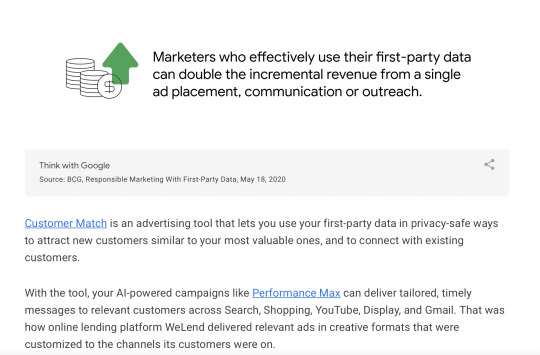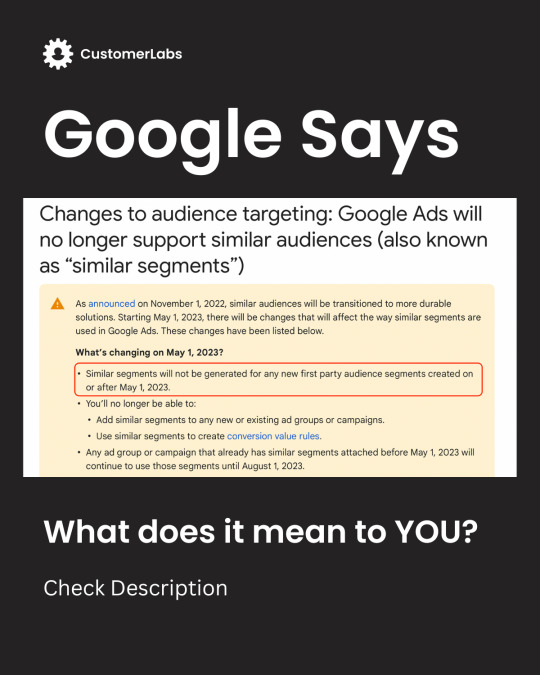Text

Think With Google says again!
Use First-party data to attract new customers similar to your existing ones. They will be the most valuable customers you could gain.
AI, Machine learning and Automation all need your first party data to understand your audiences, expand your audience net, and run your ad campaigns effectively.
Check out how Automated Bidding works in using your first-party data and gets you higher audience -
https://www.customerlabs.com/blog/automated-bidding-strategy-in-google-ads/
1 note
·
View note
Text

Does it matter to you?
0 notes
Text

Many marketers get confused and are unsure if to go for automated bidding strategies because they feel automation will take the full control away from them.
But is it really worth it to get worried and stick with manual bidding?
I've written a comprehensive blog explaining about automated bidding. Go through it and let me know if it was useful for you and if I missed anything or could add anything.
1 note
·
View note
Text
How do you collect customer data for your marketing campaigns?

If you want to collect, store and use your audience data across various platforms, you should use a Customer Data Platform like CustomerLabs.
1 note
·
View note
Text
How do you collect customer data for your marketing campaigns?

If you want to collect, store and use your audience data across various platforms, you should use a Customer Data Platform like CustomerLabs.
#first party data#digitalmarketing#customer data platform#customer data#marketing#ecommerce#socialmediamarketing
1 note
·
View note
Text
First-party data blog that is useful for marketers!

As a marketer, you've likely heard the term "first-party data" thrown around quite a bit. But what is it, exactly, and why is it so important? In this post, we'll explore what first-party data is, why it matters, and how you can effectively leverage it in your marketing strategy.
What is First-Party Data?
First-party data refers to data that a business collects directly from its customers or website visitors. This can include information like contact details, purchase history, website behavior, and demographic information. Essentially, any data that a customer willingly shares with a business is considered first-party data.
How is First-Party Data Different from Second- and Third-Party Data?
Second-party data refers to data that is collected by another entity (such as a partner or vendor) and shared with your business. For example, if you run a marketing campaign with a partner company and they share their customer data with you, that would be considered second-party data.
Third-party data, on the other hand, refers to data that is collected by a separate entity (such as a data provider) and sold to businesses. This can include information like purchasing habits, interests, and behavior patterns.
Why is First-Party Data Important?
Now that we know what first-party data is, let's explore why it's so important for marketing. Here are a few key reasons:
Improved Targeting and Personalization: First-party data allows businesses to better understand their customers and target them with more relevant and personalized marketing messages. By using data to better understand their customers and tailor their marketing efforts accordingly, businesses can drive more conversions and ultimately, increase their revenue.
Better Customer Experience: Using first-party data can also help businesses improve the customer experience by providing more personalized and relevant content. By providing tailored content and messaging to customers based on their interests and behavior, businesses can improve customer satisfaction and loyalty.
Compliance with Data Privacy Regulations: With the increasing focus on data privacy regulations like GDPR and CCPA, using first-party data can help businesses ensure that they're collecting and using data in a compliant way. Because first-party data is collected directly from customers, businesses have more control over how it's collected, stored, and used.
Increased ROI: Finally, using first-party data can help businesses achieve a higher return on ad spend (ROAS) by improving targeting, personalization, and customer experience.
How to Leverage First-Party Data in Your Marketing Strategy
Now that we understand the importance of first-party data, let's explore how businesses can effectively leverage it in their marketing strategies. Here are a few key steps to consider:
Collect and Store Data in a Centralized Location: To effectively use first-party data, businesses need to ensure that it's collected and stored in a centralized location. Common tools for storing and managing first-party data include customer data platform (CDP), customer relationship management (CRM) systems and data management platforms (DMPs).
Use Data to Segment Your Audience: Once you have your first-party data collected and organized, you can use it to segment your audience into different groups based on shared characteristics or behaviors. This can help you tailor your marketing efforts to each group and improve their overall experience.
Personalize Your Marketing Messages: Using first-party data to personalize your marketing messages is one of the most effective ways to improve engagement and conversion rates. You can use the data you've collected to create targeted campaigns that speak directly to each customer's needs and interests.
Monitor and Analyze Performance: Finally, it's important to monitor and analyze the performance of your first-party data campaigns to ensure that you're achieving your goals. You can use metrics like conversion rates, click-through rates, and ROAS to measure
Wondering who wrote this blog? It is ChatGPT!
I have given it the blog I have written and asked it to write a different perspective. I felt it did a bad job. What do you feel?
Check the blog I have written here - https://medium.com/@goutham.veerabathini/my-first-post-the-first-party-data-why-marketers-should-collect-it-now-efe12125e294
1 note
·
View note
Text

Read the comprehensive blog on What is first-party data and how to collect it.
3 notes
·
View notes